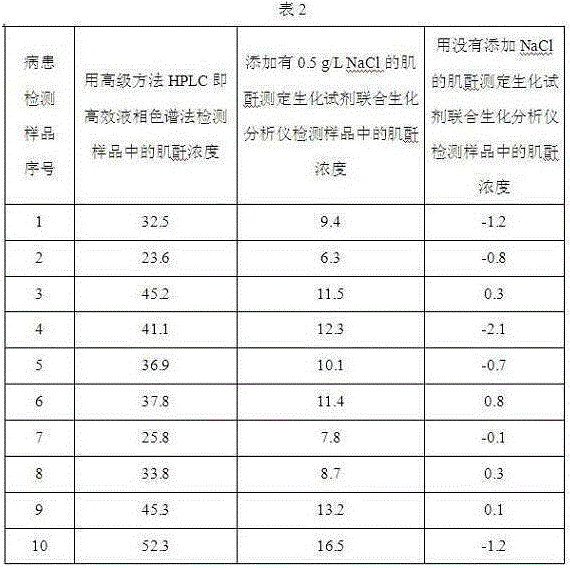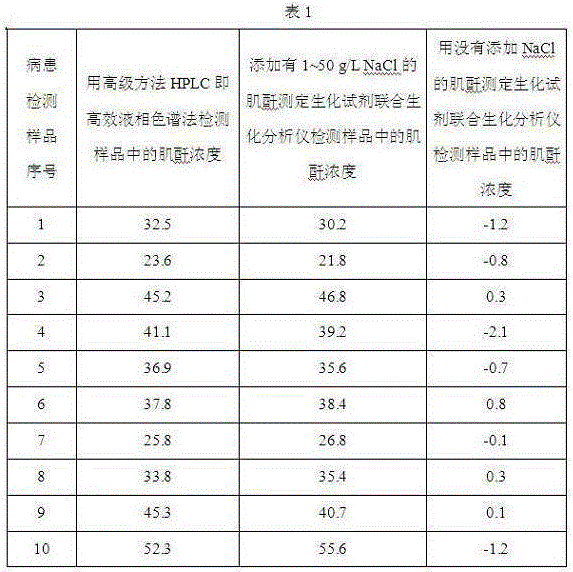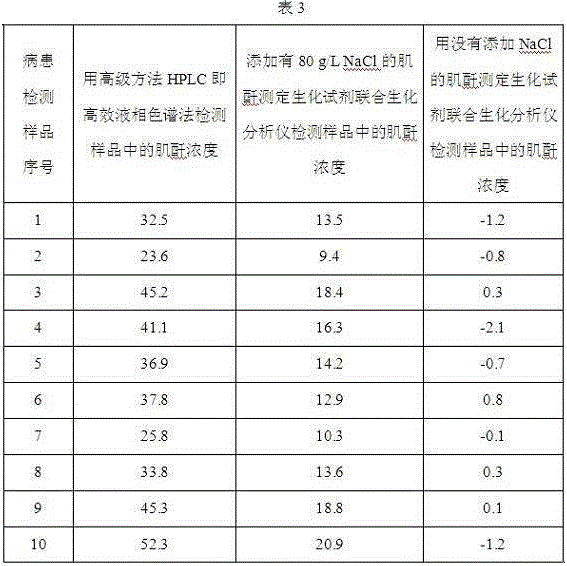Application of chloride salt in the preparation of biochemical reagents that eliminate negative or zero values in assay results
A biochemical reagent, chloride salt technology, applied in biochemical equipment and methods, microbial determination/inspection, etc., can solve the problem of inability to accurately determine the concentration of chemical components in patients, and achieve the effect of eliminating zero or negative values.
- Summary
- Abstract
- Description
- Claims
- Application Information
AI Technical Summary
Problems solved by technology
Method used
Image
Examples
Embodiment 1
[0021] Application of chloride salt in the preparation of biochemical reagents that eliminate negative or zero values in assay results. Adding chloride salts to biochemical reagents, chloride salts can provide a suitable storage and reaction environment for the analyte, so that the analyte exhibits due biological activity and maintains the natural conformation of the analyte; and participates in The composition of the substance to be tested or the active center of the tool enzyme ensures the normal progress of the reaction and obtains real test results, and eliminates the phenomenon of zero or negative values in the test sample results.
Embodiment 2
[0023] The application of chloride salt in the preparation of biochemical reagents that eliminate negative or zero values in the determination results, adding chloride salts during the configuration of biochemical reagents. The chloride salt is NaCl or MgCl 2 or CaCl 2 . NaCl, MgCl 2 , CaCl 2 The concentrations of the three are 1-50g / L. Biochemical reagents include biochemical reagents for creatinine determination, biochemical reagents for total bile acid determination and biochemical reagent configuration for adenosine deaminase determination. NaCl, MgCl 2 , CaCl 2 The three salts usually exist in the human body or animal body. The selection of these three salts can provide a suitable storage and reaction environment for the analyte, so that the analyte can show its due biological activity. It maintains the natural structure of the analyte and participates in the formation of the analyte or tool enzyme activity center, which ensures the normal progress of the reactio...
Embodiment 3
[0025] The concentration of creatinine in the patient's serum is measured with a biochemical reagent for creatinine determination. The biochemical reagent is a double reagent. The specific process is:
[0026] The process of configuring the R1 reagent biochemical reagent is as follows: add about 700ml of purified water to a 1000ml clean beaker (the quality of the purified water meets the water requirements for in vitro diagnostic reagents), and then weigh 50mmol / L of HEPES, that is, 2-[4-(2-hydroxyethyl base)-1-piperazine]ethanesulfonic acid 11.92g, add to the beaker and stir to dissolve, then add 1ml of surfactant TX-100, namely Triton-100, stir to dissolve, then add TOOS, namely N-ethyl-N -(2-Hydroxy-3-sulfopropyl)-3-methylaniline 0.99g, add 1-10g NaCl, stir to dissolve and mix well, use 20% NaOH to initially adjust pH to 7.6, dilute to 1000ml, then add Sarcosine oxidase 10ku, creatine amidinohydrolase 50ku;
[0027] The process of configuring the R2 reagent biochemical re...
PUM
 Login to View More
Login to View More Abstract
Description
Claims
Application Information
 Login to View More
Login to View More - R&D
- Intellectual Property
- Life Sciences
- Materials
- Tech Scout
- Unparalleled Data Quality
- Higher Quality Content
- 60% Fewer Hallucinations
Browse by: Latest US Patents, China's latest patents, Technical Efficacy Thesaurus, Application Domain, Technology Topic, Popular Technical Reports.
© 2025 PatSnap. All rights reserved.Legal|Privacy policy|Modern Slavery Act Transparency Statement|Sitemap|About US| Contact US: help@patsnap.com



